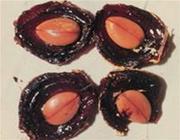According to folk experience, the fruit of the O Moi tree is used as a tonic, treating back pain and aches, and is particularly beneficial for the elderly and postpartum women.
 |
| O Moi – a specialty of the Southern region (Photo: TTO) |
The O Moi fruit has a slightly curved cylindrical shape, measuring 40-60 cm in length and 3-4 cm in diameter. Its outer skin is hard and dark brown, featuring numerous closely spaced horizontal grooves. Inside, it contains many small compartments filled with a soft, reddish-brown or black pulp that is sweet, salty, and has a pungent smell, making it edible.
According to folk experience, the O Moi fruit is used as a tonic, treating back pain and aches, and is particularly beneficial for the elderly and postpartum women. To use, select a fully ripe O Moi fruit with a hard, dried outer skin. Shake it and listen for a rattling sound inside. Crack open the fruit, extract the pulp, and soak it in half a liter of 25-30% alcohol; the longer the soak, the better. Consume two small servings daily before meals.
The O Moi fruit pulp extract is also used as a digestive stimulant and laxative. To prepare it, take 1 kg of the pulp, soak it in 1 liter of water, mash, and filter. Take the remaining pulp, soak it again in another liter of water, and then filter. Mix the two liquids and simmer on low heat until a thick syrup is achieved. Take this syrup twice a day after meals, with doses of 4-8 grams for laxative effects or 15-30 grams for cleansing.
Additionally, fresh O Moi leaves can be washed, crushed, and applied to skin irritations such as rashes or itchiness for relief after several applications. One can also prepare a leaf tincture using a ratio of 1:5 for topical application (using 25-30% alcohol). Dried O Moi leaves (30-50 grams) can be chopped and boiled in 400 ml of water until reduced to 100 ml, sweetened, and consumed in two doses throughout the day to relieve back pain and body aches.




















































